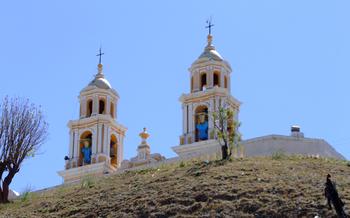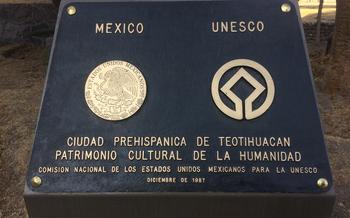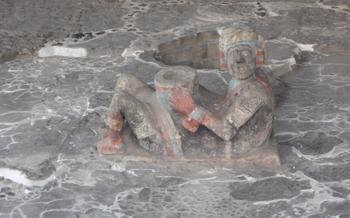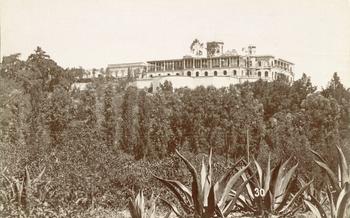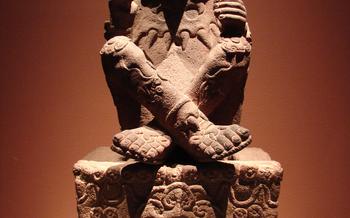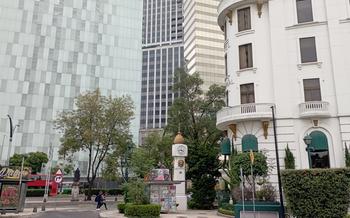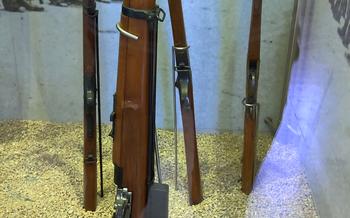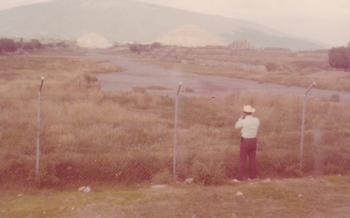
Tula Archaeological Site
- Tula Archaeological Site: A Majestic City of Ancient Mexico
- Historical Significance
- Architectural Wonders
- Cultural Artifacts
- Excavations and Ongoing Research
- Location and Accessibility
- Exploring the Pyramid of Quetzalcoatl
- The Tula Museum
- The Surrounding Area
- Planning Your Visit
- 1 Best Time to Visit
- 2 Packing Essentials
- 3 Photography Tips
- Local Cuisine
- Accommodation Options
- Safety and Security
- Responsible Tourism
- Hidden Gems and Off-the-Beaten-Path Experiences
- Photography Tips for Capturing the Best Shots
- Family-Friendly Activities
- Insider Tip: Uncovering Hidden Details
Tula Archaeological Site: A Majestic City of Ancient Mexico
In the heart of Mexico, nestled amidst the rolling hills of Hidalgo, lies the ancient city of Tula, a testament to the ingenuity and grandeur of the Toltec civilization. Once the capital of a vast empire, Tula flourished between the 9th and 12th centuries, leaving behind a legacy of awe-inspiring architecture, intricate artwork, and a captivating history that continues to intrigue and captivate visitors to this day.
Historical Significance
As the political and cultural center of the Toltecs, Tula played a pivotal role in shaping the course of Mesoamerican history. The city's strategic location along trade routes facilitated its growth and prosperity, transforming it into a thriving hub of commerce and cultural exchange. The Toltecs, known for their advanced knowledge in astronomy, mathematics, and engineering, left an indelible mark on the region, influencing the development of subsequent civilizations, including the Aztecs.
Architectural Wonders
Tula's architectural achievements stand as a testament to the Toltecs' engineering prowess and artistic vision. The city's most iconic structure, the Pyramid of Quetzalcoatl, dominates the skyline with its imposing presence. Dedicated to the revered Aztec deity, the pyramid showcases intricate carvings depicting feathered serpents, mythical creatures, and Toltec warriors. The Temple of Tlahuizcalpantecuhtli, situated adjacent to the pyramid, further showcases the Toltecs' architectural mastery, featuring elaborate murals and sculptures that offer a glimpse into their religious beliefs and practices.
Cultural Artifacts
The Tula Archaeological Site has yielded a treasure trove of artifacts that provide invaluable insights into Toltec culture and daily life. Excavations have unearthed ceramic vessels, stone sculptures, jewelry, and tools, each offering a unique perspective on the Toltecs' artistic traditions, technological advancements, and social organization. These artifacts, carefully preserved and displayed in the on-site museum, offer a tangible connection to the past, allowing visitors to appreciate the ingenuity and creativity of this ancient civilization.
Excavations and Ongoing Research
The Tula Archaeological Site remains an active center of research and exploration. Ongoing excavations continue to shed light on the city's history, uncovering new structures, artifacts, and insights into the Toltec way of life. Archaeologists and historians collaborate to piece together the complex puzzle of Tula's past, deciphering ancient inscriptions, analyzing artifacts, and reconstructing the city's layout. These ongoing efforts contribute to our understanding of the Toltec civilization, ensuring that their legacy continues to inspire and fascinate generations to come.
Location and Accessibility
The Tula Archaeological Site is conveniently located just 60 miles north of Mexico City, making it an ideal day trip from the capital. Getting there is a breeze, with several transportation options available. If you prefer public transportation, hop on the comfortable ADO bus from Mexico City's Terminal Norte, which will take you directly to Tula in about two hours. Alternatively, driving your own car or renting one offers the flexibility to explore the surrounding area at your own pace. Once you arrive at the site, immerse yourself in the grandeur of the ancient city by opting for a guided tour. Knowledgeable guides will lead you through the ruins, bringing the history and culture of the Toltecs to life with their captivating storytelling. Embrace the opportunity to ask questions and gain insights into the significance of the various structures, artifacts, and symbols that make Tula so remarkable.
Exploring the Pyramid of Quetzalcoatl
Architectural Features
The Pyramid of Quetzalcoatl, the iconic structure at the Tula Archaeological Site, stands as a testament to the Toltec civilization's architectural prowess. Towering over the ancient city, the pyramid showcases a unique design that sets it apart from other Mesoamerican pyramids. Its stepped construction, composed of six levels, creates a sense of grandeur and monumentality. Intricate carvings adorn the pyramid's exterior, depicting various deities, mythical creatures, and scenes from Toltec life. These elaborate decorations provide a glimpse into the religious beliefs and cultural practices of the ancient Toltecs.
The Feathered Serpent
The pyramid's most distinctive feature is its association with Quetzalcoatl, the revered Aztec god often depicted as a feathered serpent. The pyramid's name, which translates to "Temple of Quetzalcoatl," reflects this divine connection. According to legend, Quetzalcoatl descended from the heavens and landed on this very spot, making it a sacred site for the Toltecs. The pyramid's design incorporates numerous representations of Quetzalcoatl, including colossal serpent heads that flank the grand staircase leading to the temple at the pyramid's summit. These symbolic elements reinforce the pyramid's significance as a place of worship and veneration for the Toltec people.
The Temple of Tlahuizcalpantecuhtli
Adjacent to the Pyramid of Quetzalcoatl stands the Temple of Tlahuizcalpantecuhtli, dedicated to the Toltec god of the morning star. This smaller temple shares a close connection with the larger pyramid, both physically and symbolically. The two structures are aligned on the same axis, creating a sacred pathway that connects the earthly realm with the celestial sphere. The Temple of Tlahuizcalpantecuhtli features its own intricate carvings and iconography, representing the Toltec's reverence for the morning star and its association with the new beginnings and the cycle of life.
The Tula Museum
The Tula Museum, located within the archaeological site, is a treasure trove of artifacts that provide a deeper understanding of Toltec culture and history. Its collection includes a vast array of sculptures, pottery, jewelry, and other objects excavated from the site. These artifacts offer a glimpse into the daily life, religious beliefs, and artistic traditions of the Toltec civilization.
The museum's exhibits are well-organized and informative, with detailed explanations and labels in both Spanish and English. Interactive displays, such as touch screens and multimedia presentations, bring the Toltec civilization to life and make learning about their history and culture an engaging experience.
In addition to the permanent collection, the museum also hosts temporary exhibitions that focus on specific aspects of Toltec art, archaeology, or history. These exhibitions often feature rare artifacts and provide a unique opportunity to learn more about this fascinating civilization.
Whether you are a history buff, an archaeology enthusiast, or simply curious about pre-Columbian cultures, a visit to the Tula Museum is a must. It offers a comprehensive overview of Toltec civilization and provides a deeper appreciation for the rich cultural heritage of Mexico.
The Surrounding Area
In the vicinity of Tula, there are several other captivating destinations that offer a glimpse into the region's rich history and cultural heritage.
-
Xochicalco Archaeological Zone: Journey to Xochicalco, an ancient city that predates the Toltecs. Explore its impressive architecture, including the Pyramid of the Feathered Serpent, which rivals Tula's iconic pyramid in its grandeur. Marvel at the intricate carvings and sculptures that adorn its structures, offering a glimpse into the artistry and symbolism of this ancient civilization.
-
Tepotzotlán: Embark on a trip to the nearby town of Tepotzotlán, renowned for its stunning baroque architecture. Visit the Templo de San Francisco Javier, a magnificent church that showcases intricate facades, opulent interiors, and an impressive collection of religious art. Immerse yourself in the town's colonial charm, wandering through its cobblestone streets and admiring the well-preserved historical buildings.
-
Grutas de la Estrella: Discover the enchanting Grutas de la Estrella, a network of caves located just outside Tula. Descend into the subterranean world and marvel at the intricate stalactite and stalagmite formations that adorn the caves' chambers. Explore the various tunnels and galleries, learning about the geological processes that shaped these natural wonders.
Planning Your Visit
1 Best Time to Visit
Deciding on the best time to visit Tula depends on your preferences and priorities. While the site remains open year-round, the weather conditions can vary significantly. Generally, the dry season, which runs from November to April, offers the most pleasant weather for exploring the ruins. During these months, the skies are clear, the humidity is low, and the temperatures are moderate, ranging from the mid-60s to the low 80s Fahrenheit.
If you're interested in experiencing a vibrant cultural atmosphere, plan your trip to coincide with one of Tula's many festivals or events. The annual Toltec Cultural Festival, held in March, is a highlight, showcasing traditional dances, music, and culinary delights that bring the ancient city's heritage to life. Additionally, the Day of the Dead celebrations in November are a unique opportunity to witness the local traditions honoring the departed.
2 Packing Essentials
To ensure a comfortable and enjoyable visit to Tula, pack accordingly. Comfortable walking shoes are a must, as you'll be doing a fair amount of walking on uneven surfaces. Sun protection is also essential, so bring a hat, sunglasses, and sunscreen to shield yourself from the intense Mexican sun.
Staying hydrated is crucial, especially in the warmer months. Bring a refillable water bottle and make use of the water fountains located throughout the site. If you have any specific medications or dietary requirements, pack an adequate supply, as access to pharmacies or specialized food options may be limited.
3 Photography Tips
Capturing the grandeur of Tula's ruins through photography is a rewarding experience. To make the most of your photo opportunities, consider the following tips:
-
Composition and Framing: Pay attention to the composition of your shots. Experiment with different angles and perspectives to create visually appealing images. Frame your subjects carefully, using elements like leading lines, symmetry, and depth of field to enhance the impact of your photographs.
-
Lighting Conditions: Lighting can make or break a photograph. Visit Tula during the golden hours, around sunrise or sunset, when the soft, warm light casts a magical glow on the ruins. Avoid harsh midday light, which can create unflattering shadows and washed-out colors.
-
Unique Perspectives: Don't just stick to the obvious shots. Explore the site and seek out unique vantage points that will give your photographs a fresh perspective. Climb to the top of the pyramids for panoramic views, crouch down low to capture interesting angles, or use a drone to capture aerial shots.
Local Cuisine
Embark on a culinary journey through time as you explore the flavors of ancient Toltec cuisine. Local restaurants in Tula proudly offer traditional dishes inspired by historical recipes, allowing you to savor the tastes of a bygone era. Indulge in the rich and complex flavors of these dishes, which have been passed down through generations, ensuring the preservation of Toltec culinary heritage.
Venture beyond the restaurants and immerse yourself in the vibrant street food scene of Tula. Sample the tantalizing array of tacos, tamales, and other regional specialties, each bursting with unique flavors and textures. These culinary delights, prepared with fresh, local ingredients, offer a glimpse into the everyday lives of the Toltec people.
For a truly immersive experience, visit the local markets, where you can mingle with locals and discover a treasure trove of fresh produce, handmade crafts, and delectable local delicacies. The vibrant atmosphere of these markets is a testament to the enduring spirit of the Toltec culture.
Accommodation Options
Tula offers a range of accommodation options to suit different budgets and preferences. For a comfortable and convenient stay, consider booking a room at one of the modern hotels located near the archaeological site. These hotels often provide amenities such as swimming pools, restaurants, and fitness centers.
If you prefer a more unique and immersive experience, opt for a stay at a traditional hacienda or a charming bed and breakfast. These accommodations often feature colonial-style architecture, lush gardens, and personalized service. They offer a glimpse into the region's rich history and culture, allowing you to fully embrace the local ambiance.
No matter your choice of accommodation, remember to book in advance, especially during peak tourist seasons, to secure your preferred room and avoid any last-minute surprises.
Safety and Security
When exploring Tula, safety should be a top priority. Here are some tips to ensure a secure and enjoyable visit:
-
General Safety Tips: Remain vigilant and aware of your surroundings. Avoid walking alone at night, especially in secluded areas. Keep valuables safe and secure, and be wary of pickpockets and petty theft.
-
Local Customs and Etiquette: Respect local customs and traditions to avoid misunderstandings and ensure a positive interaction with the community. Dress modestly, especially when visiting religious sites. Be mindful of noise levels and avoid disturbing the tranquility of the archaeological site.
Responsible Tourism
As a responsible traveler, it's essential to adopt sustainable practices and cultural sensitivity during your visit to Tula. Choose eco-friendly transportation options, such as buses or trains, to minimize your carbon footprint. Reduce plastic waste by carrying a reusable water bottle and avoiding single-use plastics. Support local businesses by shopping at local markets and dining at family-run restaurants. This helps preserve traditional livelihoods and contributes to the local economy.
Additionally, demonstrate cultural sensitivity by respecting local customs and religious beliefs. Dress modestly when visiting temples or sacred sites, and avoid taking photographs of people without their permission. Learn a few basic Spanish phrases to communicate with locals and show your appreciation for their culture. By embracing responsible tourism practices, you can positively impact the Tula community and ensure the preservation of its rich cultural heritage for future generations.
Hidden Gems and Off-the-Beaten-Path Experiences
While Tula is undoubtedly a prominent archaeological site, venturing beyond its boundaries offers a unique opportunity to explore lesser-known gems that provide a deeper understanding of pre-Columbian history. In the surrounding region, you'll find a wealth of hidden treasures waiting to be discovered.
One such hidden gem is the archaeological site of El Cerrito, located just a short drive from Tula. This ancient city, predating the Toltecs, boasts impressive structures, including a large pyramid and a complex system of underground tunnels. While less excavated and restored compared to Tula, El Cerrito offers a glimpse into the lives of an earlier civilization and a chance to experience the thrill of exploring an archaeological site that is still revealing its secrets.
Another off-the-beaten-path destination is the Otomi village of San Ildefonso, situated in the nearby Sierra Madre Oriental mountains. This charming village, inhabited by the indigenous Otomi people, showcases a rich cultural heritage and traditions that have been passed down through generations. Visitors can immerse themselves in the local culture by interacting with the Otomi artisans, learning about their traditional crafts, and sampling their delicious cuisine.
To truly experience the essence of the region, consider attending one of the local festivals or events that celebrate Toltec traditions, music, and dance. These vibrant celebrations offer a unique opportunity to witness the rich cultural heritage of the region and connect with the local community. Ask your hotel concierge or a local tour operator for information on upcoming events during your visit.
Photography Tips for Capturing the Best Shots
Capturing the essence of Tula's ancient ruins through photography requires a combination of technical expertise and creative vision. Here are some tips to help you create stunning photographs that will preserve your memories:
-
Composition and Framing: Pay attention to the composition of your shots, ensuring that the elements of the ruins are arranged in a visually appealing manner. Experiment with different angles and perspectives to create dynamic and interesting compositions.
-
Lighting Conditions: Understand how lighting conditions can affect the mood and atmosphere of your photographs. Early morning and late afternoon light often provide warm, golden tones, while midday light can create harsh shadows. Experiment with different times of day to capture the ruins in various lighting conditions.
-
Unique Perspectives: Don't be afraid to explore unique vantage points and angles to capture creative and memorable shots. Climb to higher ground for panoramic views, or get down low to capture the ruins from a different perspective. Look for interesting foreground elements, such as trees or rocks, to add depth and interest to your compositions.
Family-Friendly Activities
Make your trip to Tula an unforgettable experience for the whole family. Tula offers a range of interactive and educational activities that will engage and entertain children of all ages.
- Interactive Learning Experiences:
- Embark on a hands-on journey through history at the Tula Archaeological Museum. Interactive exhibits bring the Toltec civilization to life, allowing children to touch, see, and experience the past.
-
Participate in educational workshops and programs designed specifically for young visitors, where they can learn about ancient crafts, games, and traditions through hands-on activities.
-
Family-Friendly Tours:
- Opt for guided tours tailored to families, led by knowledgeable guides who can captivate children's imaginations with storytelling and interactive activities.
-
Look for tours that incorporate games, quizzes, and hands-on experiences to keep young minds engaged throughout the visit.
-
Picnic Spots:
- Take advantage of the designated picnic areas within the archaeological site to enjoy a leisurely family meal surrounded by ancient ruins.
- Pack a delicious spread of snacks and drinks, and let the kids run and play while you soak in the historical atmosphere.
Insider Tip: Uncovering Hidden Details
For a truly unique and immersive experience, inquire about the possibility of visiting the museum's storerooms. Here, you'll have the chance to see artifacts that are not on public display, providing a glimpse into the ongoing research and discoveries being made at Tula. The storerooms offer a behind-the-scenes look at the work of archaeologists and conservators, allowing you to gain a deeper understanding of the Toltec civilization and its enduring legacy.
